There are many devices used by musicians to enrich their music and make it more emotional for listeners. The art of muting is one of techniques that help achieve a completely new color during performance. In this article, we are going to delve into effects of muting and various types of mutes used for this purpose.

What is Muting?
Muting is an essential technical skill, which adds more colors and emotions to the performance. By exploring various types of mutes and experimenting with sound, brass players push the limits of sonic possibilities and release more character in each note.
Muting can provide many possibilities, ranging from softening the tone to adding a growling edge. Depending on the mute, musicians achieve various palettes for creative expression. The positioning of the mute from the instrument's bell affects the resulting sound. Angles and depths of mutes allow players to adjust pitch, loudness and timbre to certain musical style and context.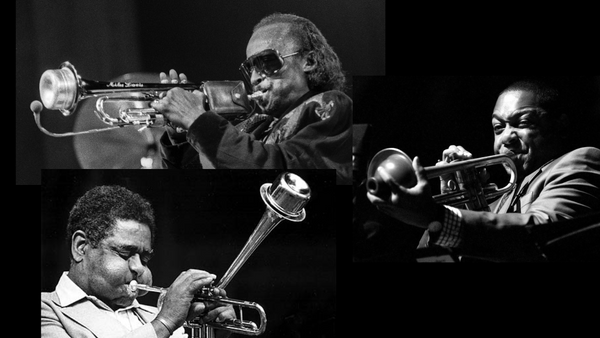
Musicians from orchestras and jazz bands use muting technique, when it’s necessary to change the tone or lower the volume of the trumpet. In their case, muting helps to seamlessly blend the horn with other instruments.
What is a Mute?
A mute is a special device for brass players, designed to lower the volume and alter the tonal quality of the instrument. Typically, during performance the mutes are inserted into brass instruments’ bell, however depending on the model they can be held in front of the instrument or clipped onto the bell. Although the English word “mute” is translated as “silence”, a muted brass instrument produces sound.
In classical music, the passages intended to play with a mute, have the notation “con sordino”, which can be translated from Italian as “with mute”. In Jazz, composers indicate the need to use a mute by the name of the mute, or the word “open” when the musician should remove the mute.
What are Different Types of Mutes?
There is a wide variety of mutes, aimed at creating a specific tonal quality. Regarding material, there are the following types:
Metal Mutes
Made of aluminum or copper, these devices produce bright and penetrating sound. As the material resonates within the bell, it allows musicians delivering a sharper and more focused tone.
Fiber Mutes
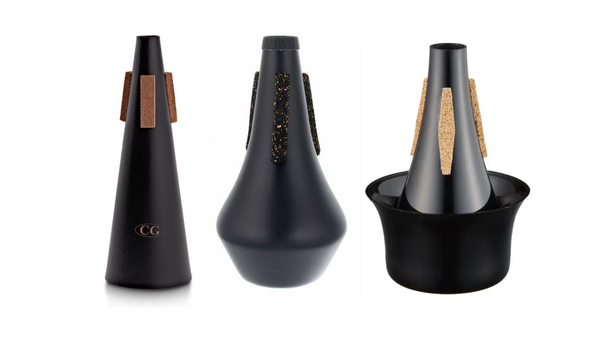
Wood Mutes
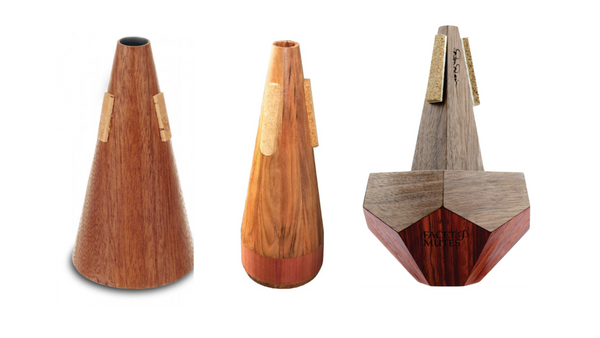
Wood devices received not so much popularity as metal or fiber models, however they provide a unique tonal quality, combining warmth and subtle resonance. They help achieve earthy, colorful and deep sound.
Plastic Mutes
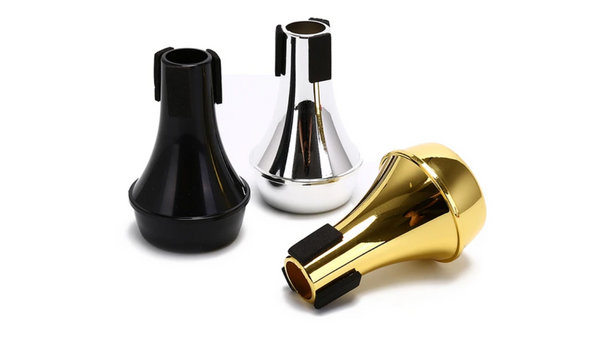
Made of plastic or synthetic materials, these mutes can have different tonal characteristics. These devices are a lightweight and comparatively cheap. Depending on configuration and design, plastic mutes can produce a wide range of sounds, from bright to resonant.
Leather Mutes
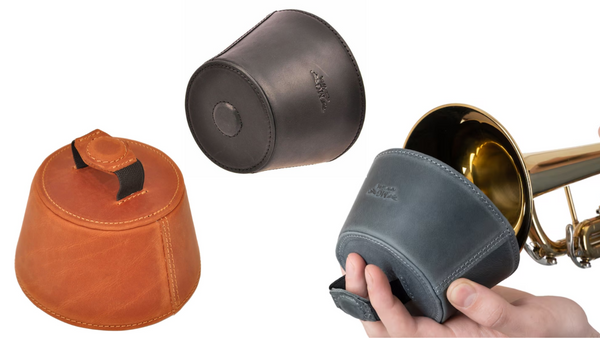
Leather mutes can help achieve velvety tone with elements of warmth and resonance. The material allows receiving softer and rounder sound compared to metal mutes. Genuine leather mutes work well for music passages requiring lyrical quality, nostalgia or romantic atmosphere. These devices also provide a pleasant tactile feel and comfortable grip, when inserting or removing them from the instrument's bell.
Regarding shapes, mutes are divided into the following types:
Straight Mute
Straight mutes have a conical shape with an opening at the smaller end. By placing them in the bell of the instrument, musicians can produce a bright sound with a slightly muted quality. These mutes are made of metal, plastic, and cardboard. Metal models are characterized by producing a bright sound, with a more “buzz”.
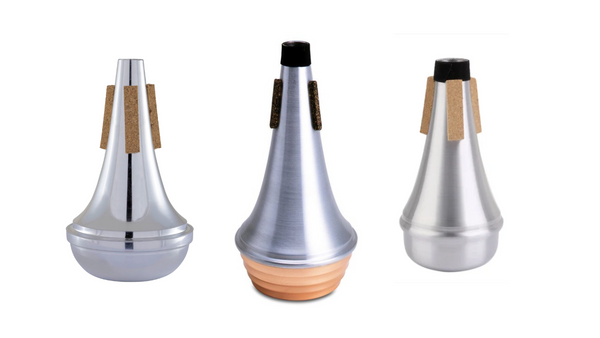
Straight mutes are popular among musicians playing in ensembles, as they help achieve a crisp articulation and cut through the rest of instruments. Aspiring brass players usually begin their acquaintance with mutes with these devices.
Cup Mute
Cup mutes have a wider part on the end, resembling a cup. To mute the sound, musicians insert them into the bell in the way when the cup covers its opening and let air escape around the edge of the mute. At the market, you can find two variations of cup mutes: adjustable cup-style mutes and felt-lined cup mutes, which are used by musicians from orchestras. Actually, it’s the second mostly used type of mutes.

Cup mutes produce a mellower muffed tone, compared to straight models, so they are typically used to render feelings of nostalgia or longing.
Harmon Mute
Harmon mutes, with their adjustable stems, help to deliver a wide range of tonal colors, including piercing, metallic timbre and haunting sound. Mainly made from aluminum, they consist of two parts: a large round bulb-shaped part and a smaller stem piece that fits inside. Harmon mutes without stems are actively used by jazz players, while mutes with stems are popular among orchestral musicians.
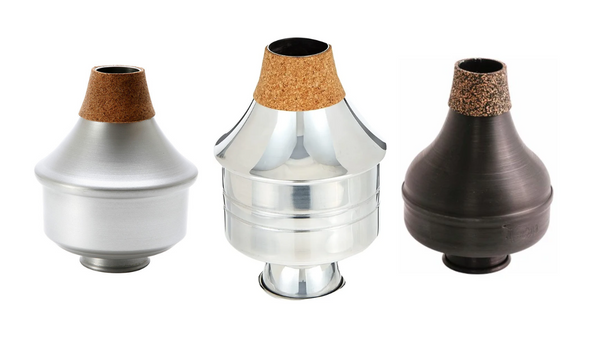
Harmon mutes are often called “wah-wah mutes” because of the especial tone they create. Dizzy Gillespie and Miles Davis like this type of mutes a lot.
Plunger Mute
These devices, mostly featuring a bathroom plunger, produce a distinctive "wah-wah" effect, created by moving the mute against the bell. Such mutes help to achieve a playful and expressive quality, as well as muted trumpet solos in jazz. By slightly covering the bell, players receive muffled sound, with subdued and veiled tones. Moreover, using a plunger mute, musicians can make the instrument sound like a vocal.
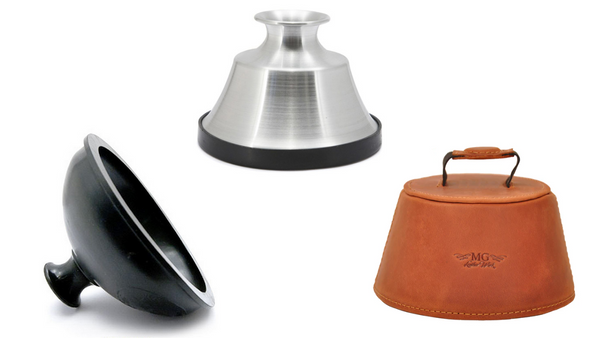
Muted sound produced by plunger mutes is present in jazz ballads and ensemble pieces, rendering warm and intimate emotions.
Bucket Mute
These devices are characterized by a round, bucket-shaped end, complemented with cotton inside. It’s designed to clip onto the outside of the bell, while some devices can also be inserted into the bell the same way as the straight mute. Bucket mutes aren’t so commonly used as other types. Musicians, particularly trombonists and trumpet players from pit orchestras and big bands, use them for specific pieces.
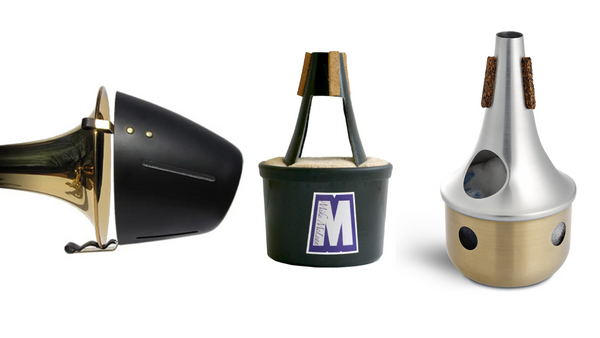
Apart from muted sound, bucket mutes can produce unique tonal effects. When musicians change the position and angle of the mute on the instrument's bell, a bucket mute affects the timbre and resonance, adds nuance and expressiveness.
Final Word
Muting technique can dramatically change the perception of the musical piece, by filling it with warmth, intimate emotions or playful vibes, depending on the type of mute used. Whether you’re a beginner, intermediate-level student, or experienced musicians, it’s useful to have a few various mutes in your collection of devices for brass instruments.

At our website, you can buy genuine leather mutes for trumpets and flugelhorns in a variety of colors. Also, check out trumpet mute adapter for quiet warm-ups and comfortable practices at home without the risk to annoy your neighbors with loud sound. Do you want to learn more about other upgrades? Then check out our useful tips on how to make your trumpet unique and one-of-a-kind.



 https://kgumusic.com/pages/about-us
https://kgumusic.com/pages/about-us